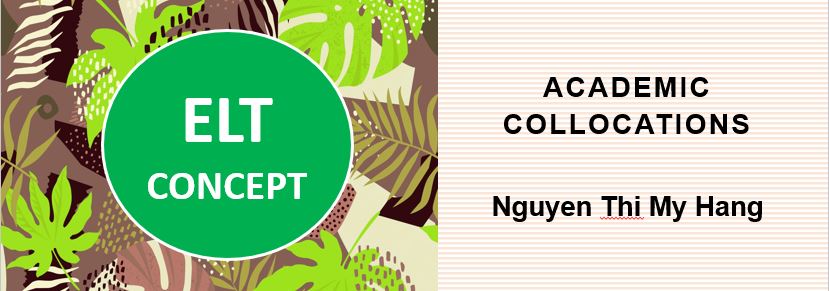ELT Concept # 14 – Academic collocations
Nguyen Thi My Hang
What is it?
English vocabulary includes not only single words (e.g., paper, necessary and remember), but also multiword units whereby words are combined in a chunk (e.g., as a matter of fact and I’m not entirely sure). The most common multiword units are collocations which refer to two words that occur together more frequently than would be expected by chance (Nguyen & Webb, 2017). For example, strong tea and heavy rain, but not strong rain and heavy tea.
Collocations can be divided into general, academic and technical depending on different contexts of language use (Henriksen & Westbrook, 2017). General collocations are used in everyday conversation and across various situations for general purposes (e.g., have lunch and make money). These collocations are essential for English learners to achieve fluency and native-like competence (Fernández & Schmitt, 2015). However, this group of collocations does not suffice for communicative success in English-medium universities. Academic collocations are used in academic settings regardless of disciplines or fields of study (e.g., ultimate goal and key element).
Knowledge of academic collocations is thus required for effective academic communication and performance. Domain-specific collocations are used for professional or academic purposes to characterize a particular field (e.g., gravitational acceleration and balanced amplifier in aviation). This group of technical vocabulary is useful for learners who want to develop their specialized knowledge in higher education instead of general learners of English for Academic Purposes (EAP).
In sum, academic collocations are two-word combinations that frequently occur in a variety of academic contexts across different disciplines. For EAP teachers and learners, this is an important concept to be aware of.
Why is it important?
Academic collocation is important for language recognition and production in academic settings. First, knowledge of academic collocations is crucial for understanding academic lectures, textbooks and materials. At the university level, the number of required and suggested readings is extensive. Given the prevalence of academic collocations in various academic texts (Lei & Liu, 2018), the lack of academic collocation knowledge would impede learners’ comprehension of materials, which in turn negatively affect their academic performance.
Second, academic collocations are especially critical in academic writing. The use of unusual word combinations or deviant collocations will have an impact on the formality and intelligibility of learners’ pieces of writing. For example, instead of using academic collocations such as external factor and central issue, leaners may use outside factor and centered issue, which is not appropriate in academic language use. For English users who want to contribute their knowledge to the academic community and publish paper in scholarly journals, insufficient knowledge of academic collocation can signal a lack of academic expertise.
My reflection
From my experience as an English learner, academic collocation appeared to be a neglected concept. I did not know about academic collocations during more than ten years of learning English in an EFL context. I only noticed this group of lexis when I pursued my higher education in an English-speaking country. Although I was already an advanced English learner at that time, my academic writing was troubled with unusual word combinations due to my lack of academic collocation knowledge. This practical experience urged me to conduct further research and learn more about this special group of vocabulary.
As an EAP teacher, I am now convinced that academic collocations deserve more attention in language teaching and learning. I constantly raise my learners’ awareness of academic collocations in several ways. I introduce some published lists of academic collocations such as the Academic Collocation List (ACL) (Ackermann & Chen, 2013) to students. They then can deliberately learn the collocations in this list using flashcards. In addition, I instruct my students on how to use the ACL highlighter (available here) to analyze academic texts or their own writings.
Users can enter a text into this online tool which will automatically highlight all the academic collocations used in the text. Learners can make use of this tool to learn new academic collocations in reading texts or to keep track of how many collocations they can employ in their writing. All of these activities aim to improve learners’ recognition and production of academic collocations.
References
Ackermann, K., & Chen, Y.-H. (2013). Developing the Academic Collocation List (ACL) – A corpus-driven and expert-judged approach. Journal of English for Academic Purposes, 12(4), 235–247. https://doi.org/10.1016/j.jeap.2013.08.002
Fernández, B. G., & Schmitt, N. (2015). How much collocation knowledge do L2 learners have? ITL-International Journal of Applied Linguistics, 166(1), 94–126.
Henriksen, B., & Westbrook, P. (2017). Responding to research challenges related to studying L2 collocational use in professional academic discourse. Vocabulary Learning and Instruction, 6(1), 32–47.
Lei, L., & Liu, D. (2018). The academic English collocation list. International Journal of Corpus Linguistics, 23(2), 216–243. https://doi.org/10.1075/ijcl.16135.lei
Nguyen, T. M. H., & Webb, S. (2017). Examining second language receptive knowledge of collocation and factors that affect learning. Language Teaching Research, 21(3), 298–320.
ELT concept #13: Formative Assessment

